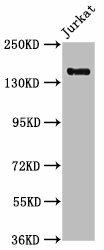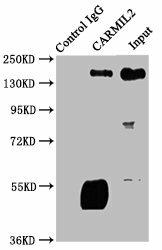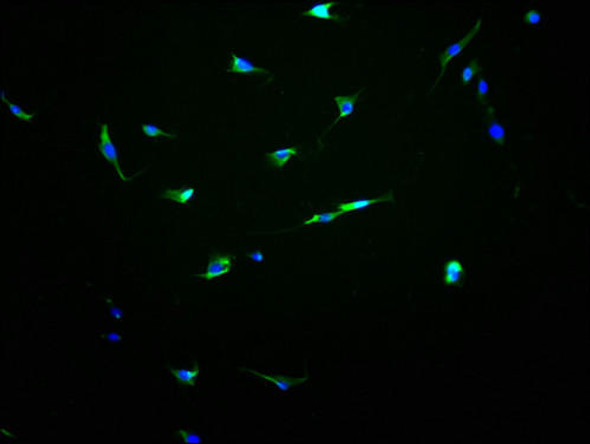Description
| Antibody Name: | CARMIL2 Antibody (PACO62483) |
| Antibody SKU: | PACO62483 |
| Size: | 50ul |
| Host Species: | Rabbit |
| Tested Applications: | ELISA, WB, IP |
| Recommended Dilutions: | ELISA:1:2000-1:10000, WB:1:500-1:2000, IP:1:200-1:2000 |
| Species Reactivity: | Human |
| Immunogen: | Recombinant Human Capping protein, Arp2/3 and myosin-I linker protein 2 protein (1136-1290AA) |
| Form: | Liquid |
| Storage Buffer: | Preservative: 0.03% Proclin 300 Constituents: 50% Glycerol, 0.01M PBS, pH 7.4 |
| Purification Method: | >95%, Protein G purified |
| Clonality: | Polyclonal |
| Isotype: | IgG |
| Conjugate: | Non-conjugated |
 | Western Blot. Positive WB detected in: Jurkat whole cell lysate. All lanes: CARMIL2 antibody at 1:1000. Secondary. Goat polyclonal to rabbit IgG at 1/50000 dilution. Predicted band size: 155, 149 kDa. Observed band size: 155 kDa. |
 | Immunoprecipitating CARMIL2 in Jurkat whole cell lysate. Lane 1: Rabbit control IgG instead of PACO62483 in Jurkat whole cell lysate.For western blotting, a HRP-conjugated Protein G antibody was used as the secondary antibody (1/2000). Lane 2: PACO62483 (6µg) + Jurkat whole cell lysate (500µg). Lane 3: Jurkat whole cell lysate (20µg). |
| Background: | Cell membrane-cytoskeleton-associated protein that plays a role in the regulation of actin polymerization at the barbed end of actin filaments. Prevents F-actin heterodimeric capping protein (CP) activity at the leading edges of migrating cells, and hence generates uncapped barbed ends and enhances actin polymerization. Plays a role in cell protrusion formations; involved in cell polarity, lamellipodial assembly, membrane ruffling and macropinosome formations. Involved as well in cell migration and invadopodia formation during wound healing. |
| Synonyms: | Capping protein, Arp2/3 and myosin-I linker protein 2 (Capping protein regulator and myosin 1 linker 2) (F-actin-uncapping protein RLTPR) (Leucine-rich repeat-containing protein 16C) (RGD, leucine-rich repeat, tropomodulin and proline-rich-containing protein), CARMIL2, LRRC16C RLTPR |
| UniProt Protein Function: | RLTPR: Belongs to the CARMIL family. 1 isoforms of the human protein are produced by alternative splicing.Chromosomal Location of Human Ortholog: 16q22.1Cellular Component: F-actin capping protein complex; membrane; cytoplasm; immunological synapse; intercellular junctionBiological Process: establishment of protein localization; cell migration; positive regulation of regulatory T cell differentiation; thymus development; homeostasis of number of cells; positive regulation of T cell proliferation; maintenance of cell polarity; T cell receptor signaling pathway |
| UniProt Protein Details: | |
| NCBI Summary: | |
| UniProt Code: | Q6F5E8 |
| NCBI GenInfo Identifier: | 66392157 |
| NCBI Gene ID: | 146206 |
| NCBI Accession: | NP_001013860.1 |
| UniProt Secondary Accession: | Q6F5E8,B8X2Z3 |
| UniProt Related Accession: | Q6F5E8 |
| Molecular Weight: | 154,689 Da |
| NCBI Full Name: | leucine-rich repeat-containing protein 16C |
| NCBI Synonym Full Names: | RGD motif, leucine rich repeats, tropomodulin domain and proline-rich containing |
| NCBI Official Symbol: | RLTPR |
| NCBI Official Synonym Symbols: | CARMIL2; LRRC16C; CARMIL2b |
| NCBI Protein Information: | leucine-rich repeat-containing protein 16C; leucine rich repeat containing 16C; RGD, leucine-rich repeat, tropomodulin and proline-rich containing protein; RGD, leucine-rich repeat, tropomodulin and proline-rich-containing protein |
| UniProt Protein Name: | Leucine-rich repeat-containing protein 16C |
| UniProt Synonym Protein Names: | RGD, leucine-rich repeat, tropomodulin and proline-rich-containing protein |
| Protein Family: | |
| UniProt Gene Name: | RLTPR |
| UniProt Entry Name: | LR16C_HUMAN |






